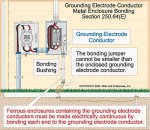I guess I'm one of "those" . I only have a draft of the '14 but the wording there is: "Ferrous metal raceways and enclosures shall be bonded at each end of the raceway or enclosure to the grounding electrode or grounding electrode conductor"as MastertheNEC pointed out. I don't see how bonding the raceway by any means accomplishes that. In earlier versions there was mention of "raceways not physically continuous" which opened the door to some consideration IMO, but the '14, if worded like my Draft Copy seems to requires bonding to the conductor. That is, of course, just my opinion.
Yeah see thats the real problem with that language. You are 100% right on the change from the 2011 NEC to the 2014 NEC as many things were added. Here is the difference in the two....and as I said prior to this I always did it the bonding bushing way....to avoid confusion....it the 2014 edition it was changed slightly.
2011 NEC - (E) Enclosures for Grounding Electrode Conductors.
Ferrous metal enclosures for grounding electrode conductors shall be electrically continuous from the point of attachment to cabinets or equipment to the grounding electrode and shall be securely fastened to the ground clamp or fitting. Nonferrous metal enclosures shall not be required to be electrically continuous.
Ferrous metal enclosures that are not physically continuous from cabinets or equipment to the grounding electrode shall be made electrically continuous by bonding each end of the raceway or enclosure to the
grounding electrode conductor. Bonding methods in compliance with 250.92(B)
for installations at service equipment locations and with 250.92(B)(2) through (B)(4) for other than
service equipment locations shall apply at each end and to all intervening ferrous raceways, boxes, and enclosures between the cabinets or equipment and the grounding electrode. The
bonding jumper for a grounding electrode conductor raceway or cable armor shall be the same size as, or larger than, the enclosed grounding electrode conductor. If a raceway is used
as protection for a grounding electrode conductor, the installation shall comply with the requirements of the appropriate raceway article.
2014 NEC (1) General.
Ferrous metal raceways and enclosures for grounding electrode conductors shall be electrically continuous from the point of attachment to cabinets or equipment to the grounding electrode and shall be securely fastened to the ground clamp or fitting. Ferrous metal raceways and enclosures shall be bonded at each end of the raceway or enclosure to the grounding electrode or grounding electrode conductor. Nonferrous metal raceways and enclosures shall not be required to be electrically continuous.
(2) Methods. Bonding shall be in compliance with 250.92(B) and ensured by one of the methods in 250.92(B)(2) through (B)(4).
this was to kinda see how both flow. Just can't get past that last line....
to the grounding electrode or grounding electrode conductor



